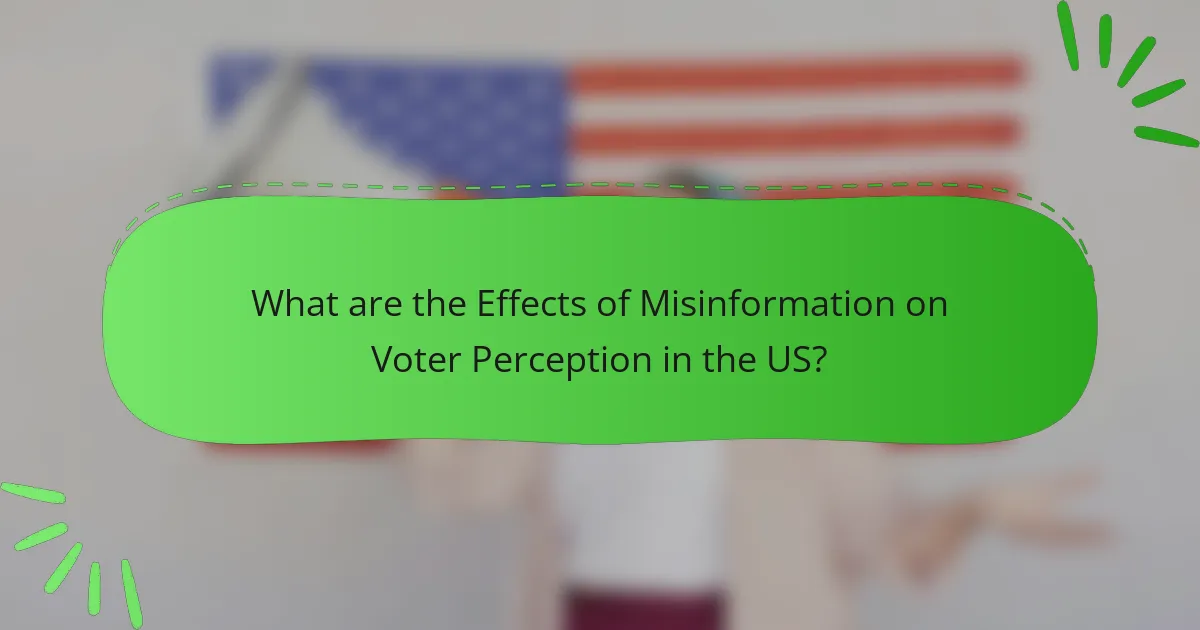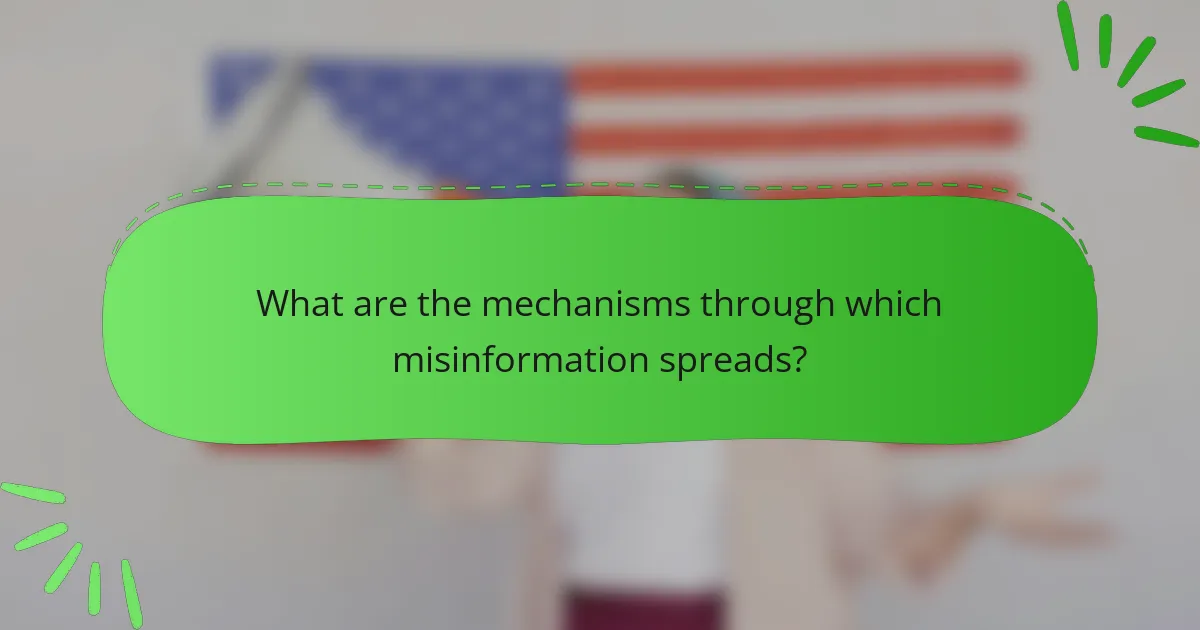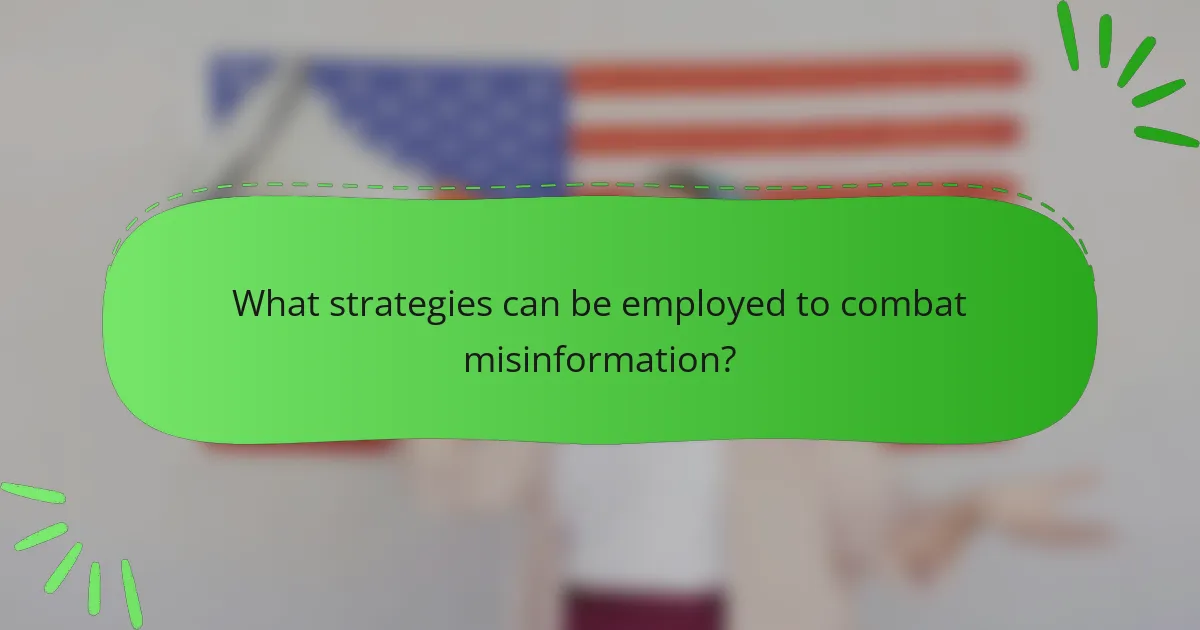Misinformation is a significant factor influencing voter perception in the United States, leading to confusion about candidates and policies, and distorting electoral outcomes. Research indicates that misinformation can decrease voter turnout and polarize public opinion on critical issues, with 64% of Americans acknowledging its impact on their political views. Various mechanisms, including social media, word of mouth, and traditional media, contribute to the rapid spread of false information, often outpacing factual content. Strategies such as fact-checking initiatives and media literacy programs are essential in combating misinformation and enhancing public awareness, ultimately fostering a more informed electorate.

What are the Effects of Misinformation on Voter Perception in the US?
Misinformation significantly impacts voter perception in the US. It can lead to confusion about candidates and policies. Voters may form opinions based on false information. This can distort electoral outcomes. Research shows that misinformation can decrease voter turnout. It can also polarize public opinion on key issues. A study by the Pew Research Center found that 64% of Americans believe misinformation affects their political views. Misinformation undermines trust in the electoral process.
How does misinformation influence voter beliefs and attitudes?
Misinformation significantly influences voter beliefs and attitudes. It can distort perceptions of candidates and issues. Voters exposed to false information may develop skewed views. Research shows that misinformation can lead to polarization among voters. For instance, a study by the Pew Research Center found that 64% of Americans believe that fabricated news stories cause confusion about the basic facts of current events. This confusion can result in misguided voting decisions. Additionally, misinformation can erode trust in the electoral process. When voters encounter conflicting information, they may become disillusioned. This disillusionment can suppress voter turnout and engagement. Overall, misinformation plays a critical role in shaping the political landscape.
What types of misinformation are most prevalent in US elections?
The most prevalent types of misinformation in US elections include false claims about voter fraud, misleading information about voting procedures, and manipulated images or videos. False claims about voter fraud often suggest that widespread illegal voting occurs, despite studies showing minimal evidence of such activity. Misleading information about voting procedures includes incorrect details regarding registration deadlines and polling locations, which can confuse voters. Manipulated images or videos are often shared on social media to misrepresent candidates or events, influencing public perception. Research from the Pew Research Center indicates that a significant portion of the public encounters misinformation during elections, impacting voter trust and behavior.
How does misinformation affect voter trust in the electoral process?
Misinformation significantly undermines voter trust in the electoral process. It creates confusion about voting procedures and candidates. When voters encounter false information, they may question the integrity of the system. Research shows that exposure to misinformation can lead to decreased confidence in election outcomes. A study by the Pew Research Center found that 64% of Americans believe misinformation affects their understanding of political issues. This erosion of trust can result in lower voter turnout. Additionally, misinformation can polarize opinions, making consensus more difficult. Overall, misinformation directly impacts the perceived legitimacy of elections.
Why is understanding the effects of misinformation important for democracy?
Understanding the effects of misinformation is crucial for democracy because it undermines informed decision-making. Misinformation can distort public perception and influence voter behavior. When citizens receive false information, they may make choices based on inaccuracies. This can lead to the election of candidates who do not represent the electorate’s true interests. A 2020 study by the Pew Research Center found that 64% of Americans believe misinformation has caused confusion about basic facts. This confusion can erode trust in democratic institutions. As a result, understanding misinformation helps safeguard the integrity of democratic processes.
What role does misinformation play in voter turnout?
Misinformation significantly impacts voter turnout by creating confusion and distrust. It can lead to disengagement from the electoral process. For instance, false information about polling dates or voter registration can discourage participation. A study by the Pew Research Center found that 64% of Americans believe misinformation affects their voting decisions. Additionally, misinformation can amplify polarization, leading to decreased turnout among specific demographic groups. This effect is particularly pronounced in younger voters who rely heavily on social media for information. Overall, misinformation undermines the integrity of the electoral process and diminishes voter engagement.
How does misinformation impact the legitimacy of election outcomes?
Misinformation undermines the legitimacy of election outcomes by eroding public trust in the electoral process. When voters encounter false information, they may question the integrity of the results. Studies show that misinformation can lead to increased skepticism about election fairness. For instance, a 2020 survey revealed that 29% of voters believed the election was rigged due to misleading claims. This skepticism can discourage voter participation and create divisions among the electorate. Additionally, misinformation can influence voter behavior by swaying opinions based on false narratives. The spread of inaccurate information on social media further amplifies these effects. Overall, misinformation creates an environment of doubt that challenges the perceived legitimacy of elections.

What are the mechanisms through which misinformation spreads?
Misinformation spreads through various mechanisms including social media, word of mouth, and traditional media. Social media platforms facilitate rapid sharing and amplification of false information. Algorithms often prioritize engaging content, regardless of its accuracy. Word of mouth allows misinformation to travel quickly within communities. Personal biases can lead individuals to accept and share false information without verification. Traditional media can inadvertently propagate misinformation through sensational reporting. Studies show that misinformation can spread six times faster than factual information on social media. This rapid dissemination can significantly influence public perception and voter behavior.
How do social media platforms contribute to the spread of misinformation?
Social media platforms contribute to the spread of misinformation by facilitating rapid information sharing. They allow users to post content without verification. This leads to the viral spread of false information. Algorithms prioritize engagement, often promoting sensational or misleading posts. A study by the Pew Research Center found that 64% of Americans believe fabricated news stories cause confusion. The ease of sharing on social media amplifies misinformation’s reach. Additionally, echo chambers form, reinforcing existing beliefs without challenge. This dynamic significantly impacts voter perception and decision-making in the US.
What specific features of social media facilitate the dissemination of false information?
Social media features that facilitate the dissemination of false information include algorithms that prioritize engagement over accuracy. These algorithms amplify sensational content, increasing its visibility. The shareability of posts allows misinformation to spread rapidly across networks. User anonymity can lead to less accountability for spreading false claims. The lack of rigorous fact-checking mechanisms enables misleading information to circulate unchecked. Additionally, echo chambers reinforce existing beliefs, making users more susceptible to accepting false narratives. Research shows that misinformation spreads six times faster than factual information on platforms like Twitter.
How do algorithms influence the visibility of misinformation?
Algorithms significantly influence the visibility of misinformation by prioritizing content based on engagement metrics. Social media platforms utilize algorithms that favor posts with higher interaction rates, such as likes, shares, and comments. This often results in sensational or misleading content being promoted over factual information. A study by the Massachusetts Institute of Technology found that false news spreads six times faster than true news on Twitter. The algorithm’s design can create echo chambers, where users are exposed primarily to information that aligns with their existing beliefs. Consequently, misinformation becomes more visible and pervasive, impacting voter perception and decision-making.
What are the psychological factors that make voters susceptible to misinformation?
Voters are susceptible to misinformation due to cognitive biases and emotional responses. Confirmation bias leads individuals to favor information that aligns with their preexisting beliefs. This bias can distort their perception of facts. Additionally, emotional appeals in misinformation can trigger strong reactions, making voters more likely to accept false information. The Dunning-Kruger effect can also play a role. It causes individuals with limited knowledge to overestimate their understanding, leading to misinformed decisions. Social identity influences susceptibility as well. Voters may prioritize group allegiance over factual accuracy. Research shows that misinformation can spread rapidly in group settings, amplifying its effects.
How do cognitive biases affect the acceptance of misinformation?
Cognitive biases significantly influence the acceptance of misinformation. These biases lead individuals to process information in a way that aligns with their pre-existing beliefs. Confirmation bias is a primary example, where people favor information that supports their views. This bias makes them more likely to accept false information that confirms their beliefs while rejecting contradictory evidence. Another relevant bias is the availability heuristic, which causes individuals to judge the likelihood of information based on how easily examples come to mind. This can lead to the acceptance of misinformation that is more memorable or emotionally charged. Research indicates that cognitive biases can distort critical thinking and decision-making. For instance, studies show that voters exposed to misleading information are more likely to accept it when it aligns with their political preferences. Thus, cognitive biases play a crucial role in how misinformation is processed and accepted among voters.
What emotional responses are triggered by misinformation campaigns?
Misinformation campaigns trigger various emotional responses, including fear, anger, and confusion. Fear arises from the perception of threats to safety or societal stability. Anger can stem from feelings of betrayal or injustice when misinformation is believed to manipulate public opinion. Confusion occurs as conflicting information leads to uncertainty about facts. Studies show that these emotional responses can significantly influence voter behavior. For instance, research by the Pew Research Center indicates that misinformation can amplify emotional reactions, leading to increased polarization among voters. This emotional turmoil can ultimately affect decision-making during elections.

What strategies can be employed to combat misinformation?
Employing fact-checking initiatives is a key strategy to combat misinformation. Fact-checking organizations verify claims made in public discourse. They provide accurate information to counter false narratives. Public awareness campaigns educate individuals about identifying misinformation. These campaigns often utilize social media to reach a broader audience. Media literacy programs teach critical thinking skills regarding information consumption. Research indicates that individuals with higher media literacy are less susceptible to misinformation. Collaboration between tech companies and fact-checkers enhances the detection of false information online. Studies show that platforms implementing fact-checking see a reduction in the spread of misinformation.
How can voters critically evaluate information sources?
Voters can critically evaluate information sources by assessing credibility, accuracy, and bias. They should verify the source’s authority and expertise on the subject. Checking for citations and references strengthens the validity of the information. Comparing multiple sources helps identify discrepancies and biases. Analyzing the language used can reveal emotional manipulation or sensationalism. Fact-checking websites provide reliable verification for claims. Understanding the context in which information is presented is crucial. These methods ensure voters make informed decisions based on trustworthy information.
What tools and resources are available for fact-checking information?
Fact-checking tools and resources include websites like Snopes, FactCheck.org, and PolitiFact. These platforms verify claims and provide evidence-based assessments. Snopes is widely recognized for debunking urban legends and viral misinformation. FactCheck.org focuses on political claims and advertisements, offering detailed analyses. PolitiFact rates statements on a Truth-O-Meter scale. Other resources include the International Fact-Checking Network, which promotes best practices. Social media platforms like Twitter and Facebook also implement fact-checking partnerships. These tools help combat misinformation, especially in the context of voter perception.
How can education improve media literacy among voters?
Education can improve media literacy among voters by providing essential skills to critically evaluate information. It teaches individuals how to identify credible sources and discern bias in media. Programs that focus on media literacy enhance understanding of how information is created and disseminated. Research indicates that educated voters are better equipped to recognize misinformation. A study by the Stanford History Education Group found that students who received media literacy training were more adept at evaluating online information. This training fosters analytical thinking, enabling voters to make informed decisions. Overall, education plays a crucial role in empowering voters against misinformation.
What role do institutions play in mitigating the effects of misinformation?
Institutions play a crucial role in mitigating the effects of misinformation. They establish guidelines and frameworks to promote accurate information dissemination. For example, educational institutions develop curricula that teach critical thinking skills. This empowers individuals to evaluate sources and discern fact from fiction. Media organizations implement fact-checking protocols to verify claims before publication. Government agencies also issue public awareness campaigns to inform citizens about misinformation tactics. Research indicates that informed voters are less susceptible to misleading information. A study by the Pew Research Center found that 64% of Americans believe misinformation is a significant problem. Thus, institutions are essential in fostering an informed electorate.
How can electoral bodies respond to misinformation during elections?
Electoral bodies can respond to misinformation during elections by implementing proactive communication strategies. They should verify facts and provide accurate information through official channels. Engaging with the public on social media can help counter false narratives. Collaborating with fact-checking organizations enhances credibility. Establishing clear reporting mechanisms for misinformation allows voters to report false claims. Educational campaigns about identifying misinformation empower voters to discern credible sources. Research indicates that timely correction of misinformation can mitigate its impact on voter perception. For example, a study by the Pew Research Center found that fact-checking can significantly influence public belief in misinformation.
What partnerships can be formed to address misinformation effectively?
Partnerships between technology companies, fact-checking organizations, and educational institutions can effectively address misinformation. Technology companies can implement algorithms to detect and limit the spread of false information. Fact-checking organizations provide accurate information and verify claims circulating online. Educational institutions can develop programs to teach critical thinking and media literacy. Collaborations among these entities can create comprehensive strategies. For instance, Facebook partnered with fact-checkers to assess the accuracy of posts. Similarly, Google collaborates with educational organizations to promote media literacy resources. These partnerships can significantly reduce the impact of misinformation on voter perception.
What best practices can voters adopt to protect themselves from misinformation?
Voters can adopt several best practices to protect themselves from misinformation. First, they should verify information from credible sources. Fact-checking websites like Snopes and FactCheck.org provide reliable assessments. Second, voters should cross-reference news stories across multiple reputable outlets. This helps identify discrepancies and biases. Third, they should be cautious of sensational headlines and clickbait. Such tactics often mislead readers. Fourth, engaging in discussions with informed individuals can provide different perspectives. This promotes critical thinking and deeper understanding. Lastly, voters should educate themselves on media literacy. Understanding how to analyze and interpret media content is essential in today’s information landscape.
The main entity of this article is misinformation and its effects on voter perception in the US. Misinformation significantly distorts voter beliefs, decreases trust in the electoral process, and can lead to lower voter turnout. The article examines the types of misinformation prevalent during elections, the psychological factors making voters susceptible, and the mechanisms through which misinformation spreads, particularly on social media. It also discusses strategies to combat misinformation, including fact-checking initiatives and media literacy education, highlighting the critical role of institutions and partnerships in mitigating its impact on democracy. Overall, the article underscores the importance of understanding misinformation to preserve informed decision-making in the electoral process.